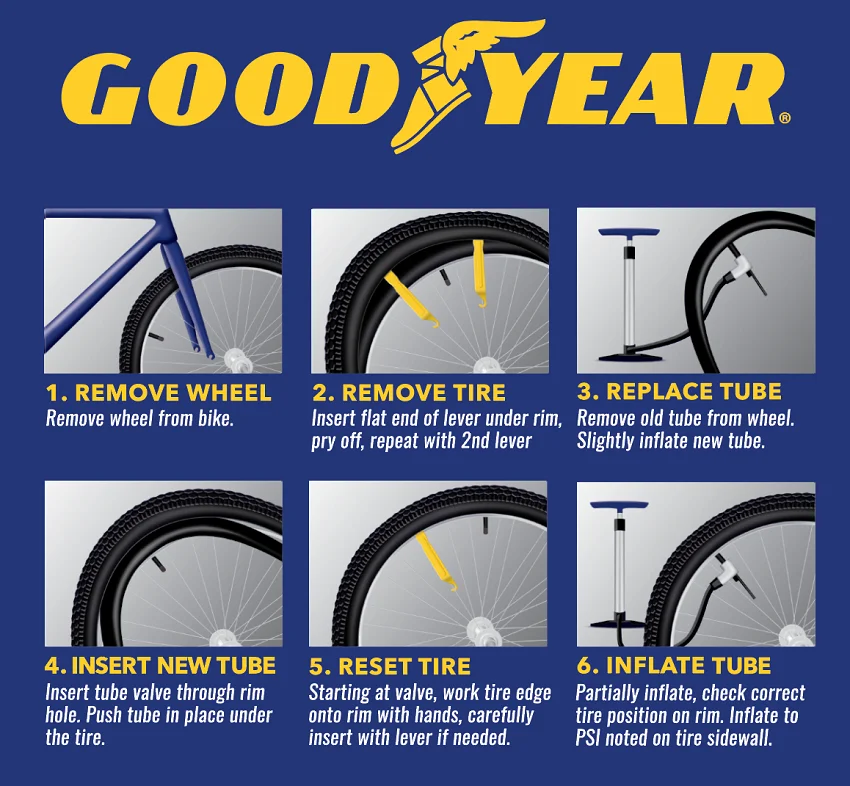Getting a flat tire is an inevitable part of cycling, and there’s only so many times you can get away with walking your bike into a shop or having a buddy on a group ride fix it for you. An essential part of knowing how to fix a flat is also knowing how to use tire levers, so there’s no time like the present to learn.
If you don’t have tire levers, don’t try using other available tools (like a flathead screwdriver) as substitutes. They could easily damage the tube, tire, or worse, the rim. Tire levers are designed specifically for removing and installing tires without damaging anything in the process, so stick with those to be safe.
Below, we explain how to use a tire lever, along with tips for dealing with tricky tires.
Join Bicycling All Access for more tips and tricks
Many tire levers are made out of hard plastic and sold in sets of two or three. You can also find levers made out of steel or with a steel core for tires that are harder to remove. All tire levers feature a curved end for slipping under the lip of the tire; depending on the brand, it could be fully rounded or squared. Many tire levers, though not all, come with a small hook on the other end so you can secure it to a spoke for leverage.
Trevor Raab
Start with the tire deflated. Pick a spot along the edge of the rim that lines up with a spoke. Pull back the tire away from the rim and fit the curved end of the lever under the edge of the tire. With the tip of the lever under the tire’s edge, press down on the lever using the rim for leverage and secure the hooked end onto the spoke. The lever should lift the edge of the tire up and over the outside of the rim and hold it in place.
Take a second tire lever and fit the curved end under the tire’s edge in the gap created by the first lever.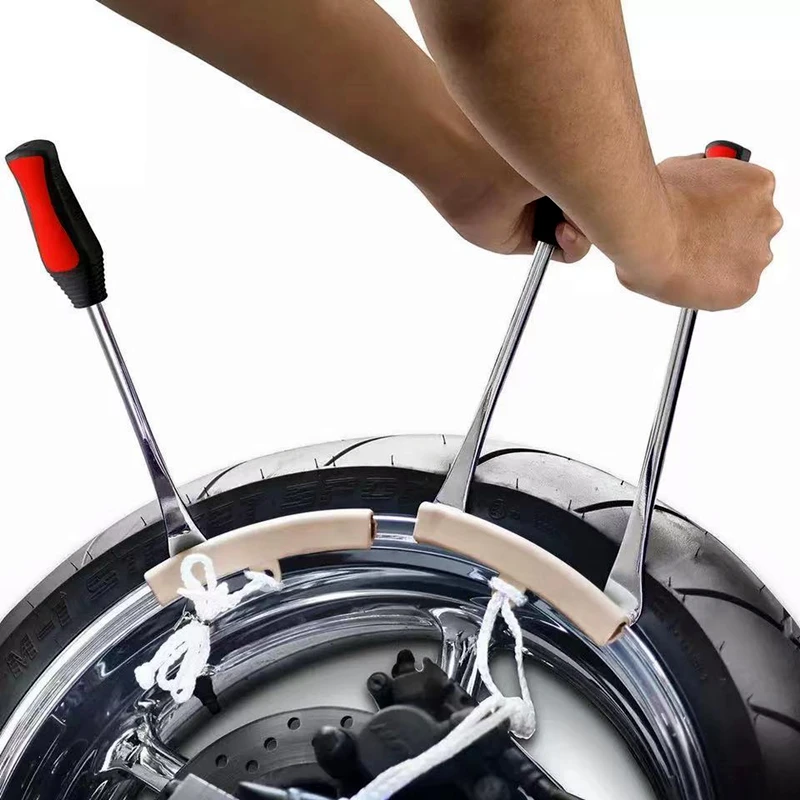 Work the second lever along the edge of the rim by sliding it laterally with the end under the tire lip until the tire comes free of the rim on one side. This step can be hard to do with tight tires—try pushing on the second lever with both thumbs.
Work the second lever along the edge of the rim by sliding it laterally with the end under the tire lip until the tire comes free of the rim on one side. This step can be hard to do with tight tires—try pushing on the second lever with both thumbs.
Trevor Raab
Trevor Raab
If the tire won’t budge using the second lever, check out our tips below. You don’t want to risk injuring yourself by using so much force that your hand slips off the lever. Alternatively, sometimes a tire can be removed using just one lever. If the tire seems loose enough after freeing the initial section with the first lever, go ahead and see if you can easily push the lever around the rim to remove the rest of the tire.
Putting a tire onto a rim is typically a bit easier than removing one, but using a tire lever might still be necessary. Fit one side of the tire onto the rim first. (If you’re using a tube, you’ll want to put that in next. ) Now, start fitting the other side of the tire onto the rim. You’ll reach a point where this becomes difficult to do because the final section of tire is too tight, leaving a small section outside the rim. You should try to intentionally leave the final section of tire to be mounted on the rim by the valve if possible.
) Now, start fitting the other side of the tire onto the rim. You’ll reach a point where this becomes difficult to do because the final section of tire is too tight, leaving a small section outside the rim. You should try to intentionally leave the final section of tire to be mounted on the rim by the valve if possible.
The next step is where your lever comes in. Place the curved end of the tire lever under the remaining section of tire with the curve facing down, hugging the inside of the rim. Lift the opposite end of the lever up while keeping the curved end planted firmly on the inside of the rim, pulling the rest of the tire onto the rim.
If there’s a larger section of tire stuck outside the rim after installing what you could with your hands, you’ll have to repeat this step on smaller sections.
$20 at Competitive Cyclist
Credit: Park ToolOur go-to for stubborn, tight fitting tires
$7 at Amazon
Credit: Pedro'sAn affordable and popular favorite
$26 at Competitive Cyclist
Credit: Park ToolThese 8-inch levers are for tough DH and Freestyle tires
$14 at REI
Credit: TopeakThese dual-purpose tire levers double as chain powerlink pliers
Still having trouble installing or removing a tire? Some tires are especially stubborn. To make it easier on yourself, here are some tricks you can try (or don’t try).
To make it easier on yourself, here are some tricks you can try (or don’t try).
→ First, what you shouldn’t do: You may have heard of some weird tricks that supposedly help with stretching a tight tire, such as throwing it in the dryer for a few minutes or using another heat source. That can end up doing more harm than good.
“Unless you know at exactly what temperature the tire’s bonding agents, rubber, and nylon start to delaminate, etc., you should not do this,” says Bicycling mechanic Joël Nankman. Instead he suggests using a little soapy water to help slip the tire into place. Just don’t get it on your hands.
→ Another pro tip from former Bicycling test editor Dan Roe: “A mechanic once showed me that you should make sure the bead core is sitting deep into the rim, rather than just resting on the hook. That makes the diameter of the rim slightly smaller and can make the difference with a really tight bead.”
That makes the diameter of the rim slightly smaller and can make the difference with a really tight bead.”
→ Misplaced your tire levers? You can sometimes just use your hands with the right technique and practice, especially with tires that aren’t very tight. Seasoned pros like mechanics might hardly ever use tire levers. The trick here is to use the palms of your hands to work the tire off or on instead of your thumbs since they’re stronger, Nankman says.
Still, injuring yourself this way from slipping, especially with sweaty hands during a midride tire repair, is no fun. (Trust us, we’ve been there.) So it’s best to have a set of tire levers on hand anyway. Of all the bike tools out there, they’re one of the most affordable and easily portable options to keep in a saddle bag or in your toolbox.
Jessica Coulon
Service and News Editor
When she’s not out riding her mountain bike, Jessica is an editor for Popular Mechanics.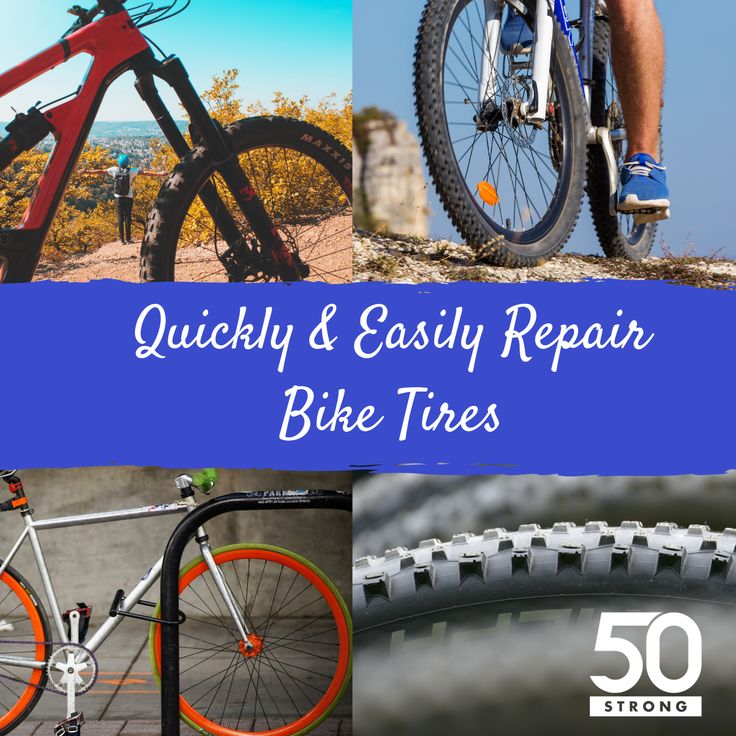 She was previously an editor for Bicycling magazine.
She was previously an editor for Bicycling magazine.
Dolors Borras
Don’t be the rider that gets caught out! Salvage your bike rides and save on the embarrassing calls home by knowing how to use tire levers to help you with puncture repairs.
It’s happened to us all once – you get a flat tire on a solo ride and can’t replace the inner tube because you cannot remove or reinstall your tire. Knowing how to use your tire levers will make those pesky puncture repairs fast and failsafe!
Read our guide to using tire levers so you’re never left calling a cab or phoning for mum again.
Ensure the inner tube is completely flat by bleeding any air out of the valve.
Use one hand to push the tire away from the wall of the wheel’s rim slightly. Dig the curved tip of the tire lever between the flat tire and the wheel rim, and scoop the curved section beneath the tire’s bead (the thick edge of the rubber).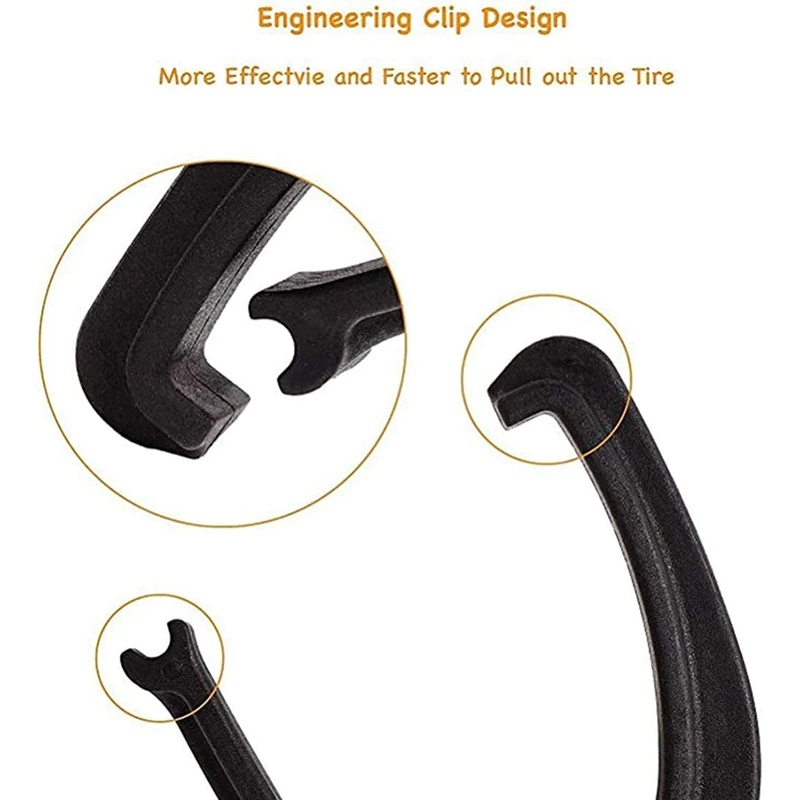
Aim to do this in line with one of the wheel’s spokes so that you can hook the other end of the lever to a spoke in the later step of the process.
Leave the lever lodged between the tire bead and wheel rim for now.
Take a second lever and repeat step one at a point approximately 5-10 inches around the wheel from where you inserted the first lever. Again, leave this second lever lodged into the bead in preparation for step 3!
Grab both levers that are stuck into the tire’s bead and ‘lever’ the tire over the rim of the wheel. This requires you to push the end of the levers down (toward the centre of the wheel), using the wheel’s rim as a pivot point.
This will pop a section of the tire out of the wheel.
You can then hook the opposite ends of the lever onto the spokes of the wheel. This will keep the tire pulled over the wheel’s rim.
One end of each lever will now be beneath the tire and the opposite end will be hooked onto a wheel spoke.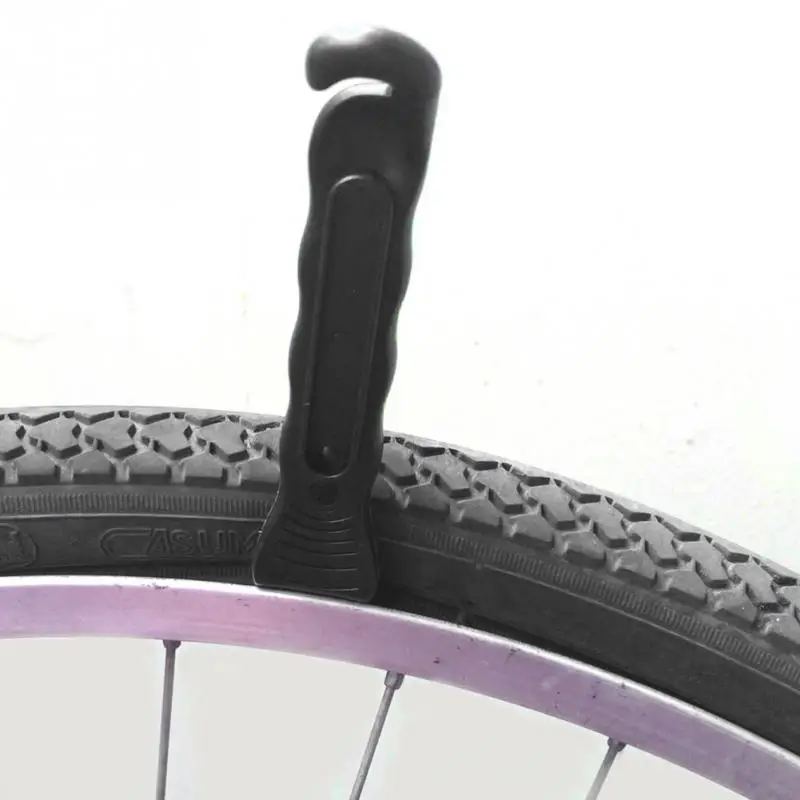
With two levers securely fastened, the tire should be almost ready to remove.
For more supple rubber, you may be able to finish the job by popping the remaining part of the tire out of the wheel with your hand.
If the tire is quite tight, take your third lever and dig it into the rim near one of your two clipped levers. Then slide this third lever around the remaining part of the tire that has not yet popped over the wheel rim. The tire should come free without you breaking a sweat!
With the tire now off the wheel rim, you can pull out the punctured inner tube and insert a fresh new one.
Don’t inflate the new tube yet!
With the new tube now inside the wheel, it’s time to pop the tire back in place.
Firstly, ensure that one side of the tire is fitted to the rim. This should be an easy process you can do with your hands.
For looser rubber, you can then use your thumbs to push the second side of the tire over the wheel’s rim and back into place – meaning your tire is now fully installed.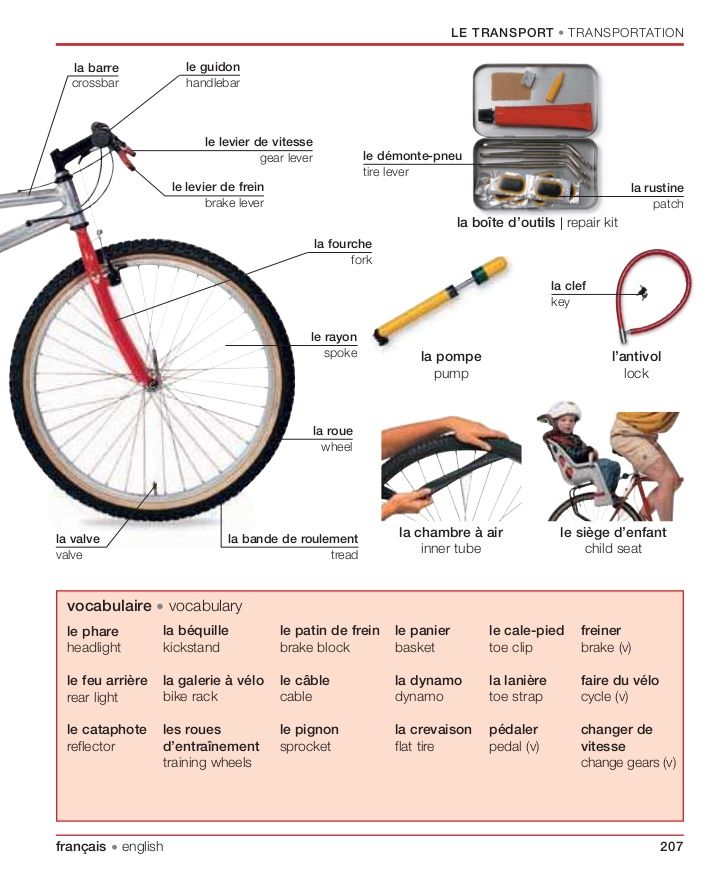
Tighter rubber may require you to use a lever to install the second side of the tire. In these cases, use your hands to get as much of the tire in place as possible. You may then find yourself with around 1/6 of the tire left to pop back over the rim.
Now take the ‘digging’ end of your lever and carefully push it between the un-mounted tire and the wheel rim. Use the curved tip to hook the lever onto the edge of the wheel rim. Now lift the opposite end of the lever up so that the tool pivots on the wheel rim, sliding the tire into the wheel.
In many cases you will now be done and the whole tire will be fully installed!
If you had a large section of tire stuck outside the rim, you may need to repeat this process on another section of the rubber before the process is complete.
Now you can pump up your inner tube and get on with enjoying the rest of your ride!
A short sentence describing what someone will receive by subscribing
Your email
100% free, Unsubscribe any time!
Follow us
Products: brake cleaners, rim cleaner.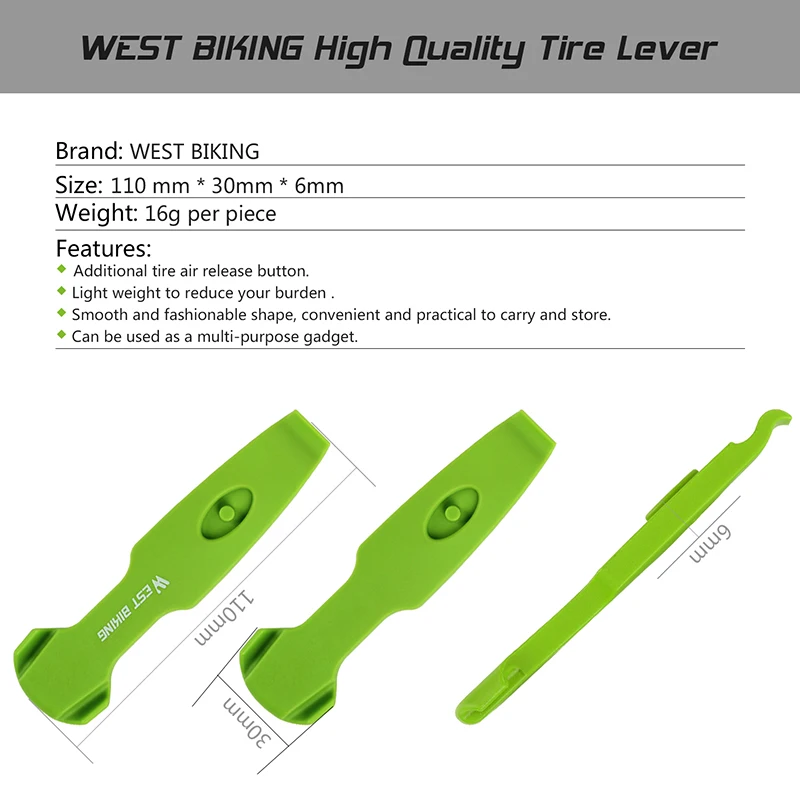
Equipment: all modern tire systems are powered by compressed air: pneumatic guns for loosening wheels, tire changer, inflation guns. Therefore, the main tool for tire fitting is a compressor. In 99% of cases, reciprocating compressors with a capacity of 400 lmin are used. These compressors require ISO VG 46 and 100 compressor oils, depending on the compressor manufacturer's recommendations. Oil change, on average, 200-250 hours when using mineral oils, that is, about once a month during the tire season. Using synthetic oils, such as Liqui Moly LM 500, article 4076, you can increase the compressor maintenance period up to two times a year. nine0003
The air gun is an essential tool for quick wheel removal. It has a lubricator lubrication system, that is, oil is supplied along with compressed air using a special lubricator-lubricator. In small tire shops, they save money on lubricators and periodically bury the oil directly into the air gun. To lubricate air guns, use Liqui Moly Oil fur Pneumatikgerat, part number 7841.
| Fig 1 | Fig 2 | Fig 3 |
To carry out work, place the vehicle at the place where the brake is to be carried out. work and fix manually Raise the vehicle with a tire jack or scissor lift, unscrew the wheel fasteners and remove the wheel. Wash the wheel in a washing machine, dry it. Using the special tool, unscrew the valve and bleed air from the wheel. Remove balancing weights, if self-adhesive weights are used, then remove the remaining glue from the rim with a rag using Liqui Moly Dichtungs Entferner. It is necessary to carefully inspect the tread for stones stuck in the sipes, since wheel balancing is meaningless with a dirty tread. If you plan to install the tire back after repair, then it is necessary to mark the position of the nipple for inflation on the tire using a special marker or chalk. The tire is installed in the same position in which it was removed from the rim. Install the cleaned wheel on the tire changer and tear off the sidewall of the tire from the rim with a spatula (Fig. 1). Next, center the wheel on the clamps (1) of the machine Fig. 2, (use plastic protective pads when working with light alloy wheels) and completely separate the sidewall of the tire from the hump with a roller (Fig. 3). Before removing the tire from the rim, apply Liqui Moly Reifen Montierenpaste to the parts of the tire adjacent to the rim. nine0003
Install the cleaned wheel on the tire changer and tear off the sidewall of the tire from the rim with a spatula (Fig. 1). Next, center the wheel on the clamps (1) of the machine Fig. 2, (use plastic protective pads when working with light alloy wheels) and completely separate the sidewall of the tire from the hump with a roller (Fig. 3). Before removing the tire from the rim, apply Liqui Moly Reifen Montierenpaste to the parts of the tire adjacent to the rim. nine0003
It is recommended to apply the paste with a flute-type brush, it is not recommended to use fly brushes (Fig. 4). Pry off the sidewall of the tire with a mounting spatula, bring it up by the heel of the machine (Fig. 5) and rotate the tire until the sidewall of the tire completely goes beyond the rim. Do the same with the bottom of the tire and remove the tire from the rim (Fig. 6).
| Figure 4 | Figure 5 | Figure 6 | nine0019
| Figure 7 | Figure 8 | Figure 9 |
Before mounting a new or refurbished tire, be sure to replace the tubeless tire valve (Fig.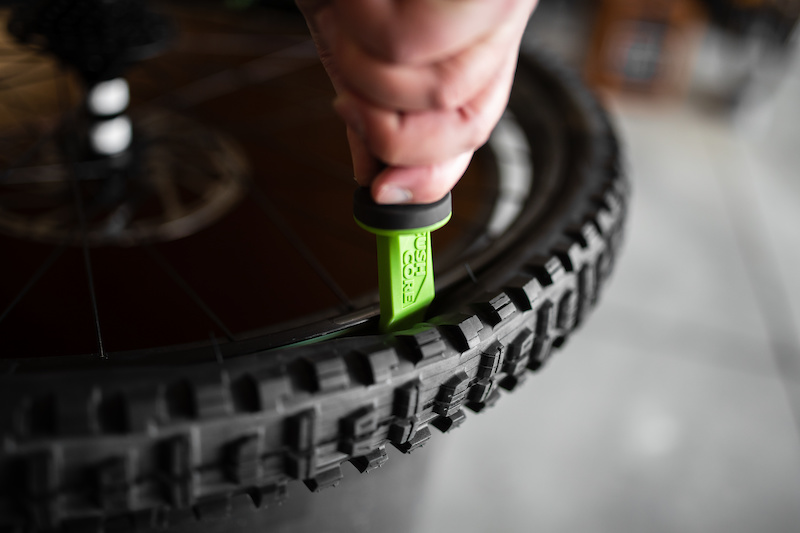 7), clean the tire contact surface with a Reiniger und Ferdunner cleaner (Fig. 8), place the rim in the wheel balancer (Fig. 9) and check the runout of the rim .
7), clean the tire contact surface with a Reiniger und Ferdunner cleaner (Fig. 8), place the rim in the wheel balancer (Fig. 9) and check the runout of the rim .
To mount the tire, it is necessary to put the disk back into the clamps of the machine (Fig. 2). Before installing the tire, apply mounting paste to the sidewalls of the tire adjacent to the rim (Fig. 10) using a flute brush on both sidewalls of the tire. Put the tire on the disc using the machine's thrust pad (Fig. 5). Orient the tire according to the marks made earlier, in case of using a new tire, align the factory mark (yellow or white) with the tire valve by location. Inflate the tire, allow the sidewall to take the correct position on the hump of the rim, for which give an air pressure of 6-8 bar (when the tire is seated, a loud bang will occur). Check the tightness of the fit by using Leck Such Spray or immersion in a water bath. After checking the tightness, bring the pressure in the wheel to the nominal value and install it in the balancing machine. Center the wheel on the center hole and studs and balance. Degrease the rim with Reiniger und Ferdunner in places where self-adhesive balance weights are fitted. nine0003
Center the wheel on the center hole and studs and balance. Degrease the rim with Reiniger und Ferdunner in places where self-adhesive balance weights are fitted. nine0003
| Fig 10 |
Before installing the wheel on the hub, treat the mating surface of the hub with your choice of (Fig. 11): Aluminum Spray, copper spray Kupfer Spray or ceramic paste Keramik Paste. The same compositions must be used to treat wheel fasteners (Fig. 12), studs or bolts (if there is a corresponding recommendation from the car manufacturer). Install the wheel on the car (Fig. 13), manually tighten the fasteners, make the final tightening to the required torque with a torque wrench. Attention: Do not use pneumatic tools to tighten wheel fasteners! nine0003
For seasonal preservation of winter or summer sets of tires, use Reifen Glanz Schaum Tire Foam.
 Errors during tire fitting
Errors during tire fitting
Tire fitting is a set of services necessary to maintain the wheels of a car in working order. It includes such activities as: removal of wheels, installation (dismantling) of tires from disks, wheel balancing. However, what if you are ever asked to explain what tire fitting is in the language of professionals? The word montage (from the French montage) means - assembly, installation of something. Whether it's tires, cabinets - it doesn't matter. Therefore, if you translate from Russian into Russian, it turns out that tire fitting = installing tires. nine0003
Naturally new tyres, because the installation of used tires does not give any guarantee for a long service life. We will tell you about the choice of tires in a separate article, and now we will analyze the process of performing tire fitting and answer the question “do I need tire fitting in a car service”?
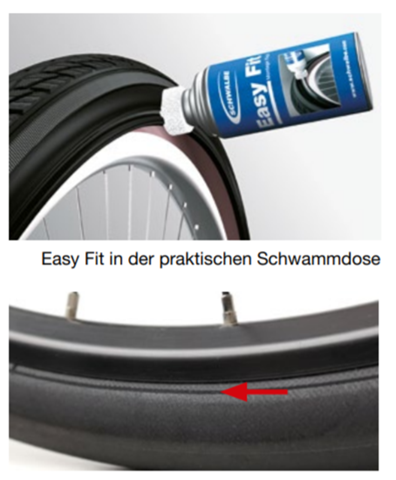 There is nothing complicated or unusual about it.
There is nothing complicated or unusual about it. 
First, let's list all the advantages of tire service in car services:
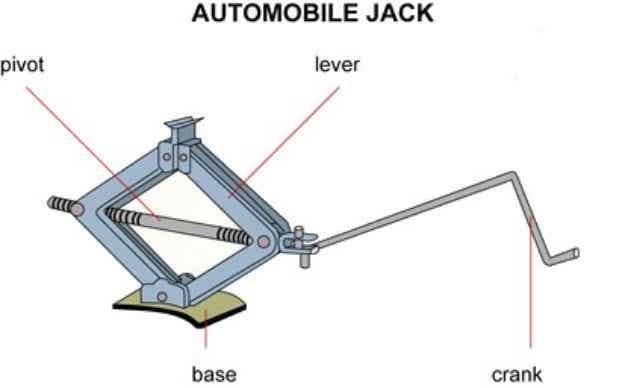 In addition, the service has the necessary equipment, for the same balancing there is the necessary stand. Also in modern alloy wheels, holes are made for the so-called "thin-walled" keys. Without a special wrench or wrench, it is possible to peel off the paintwork, which in turn will lead to corrosion of the discs. Also adjusting the tire pressure is another job. In order to correctly set the pressure, you need to know the information from the manual, imagine how loaded the machine is, etc. nine0113
In addition, the service has the necessary equipment, for the same balancing there is the necessary stand. Also in modern alloy wheels, holes are made for the so-called "thin-walled" keys. Without a special wrench or wrench, it is possible to peel off the paintwork, which in turn will lead to corrosion of the discs. Also adjusting the tire pressure is another job. In order to correctly set the pressure, you need to know the information from the manual, imagine how loaded the machine is, etc. nine0113 Cons
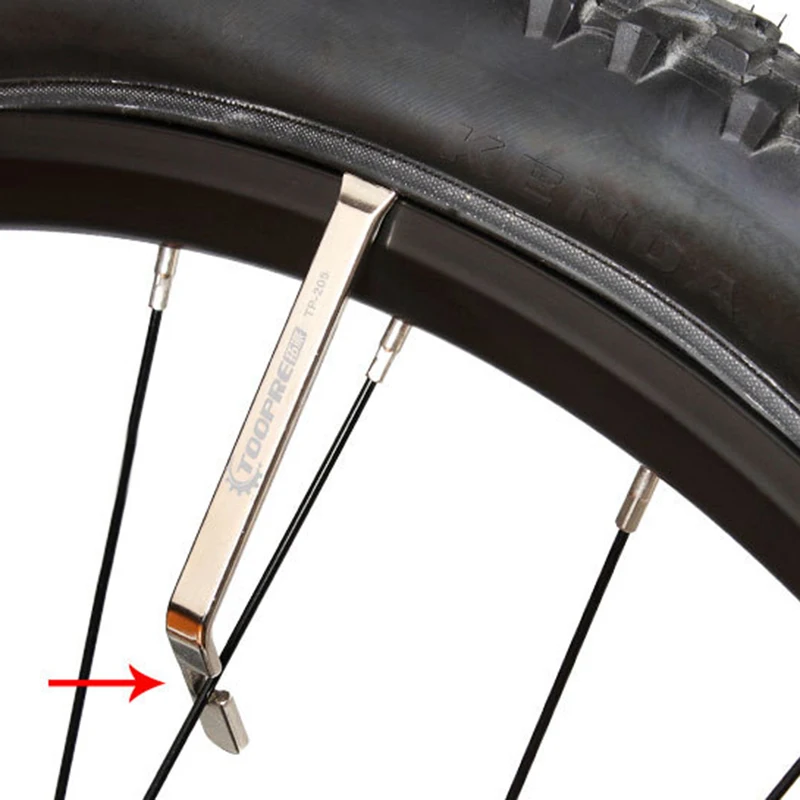 nine0112
nine0112 Tires are the only part of the car that comes into contact with the road and the most common problem with installing new tires is incorrect pressure distribution. nine0112
What happens if you overdo it with pressure? High tire pressure leads to poor grip, increased load and, as a result, an increased chance of a hernia. In general, high pressure is good for shortening the life of a tire.
And low pressure significantly increases braking distances on wet roads, reduces hydroplaning resistance, makes parking difficult, and also increases wear on steering tips - making driving as "painful" as possible.